1. SOURCES OF PREHISTORY: ARCHAEOLOGY.
1. 1. Time and the science of history.
History: the science that studies humanity's past.
Prehistory: is the period of time from the apparition of the first human beigns (2,3 million years ago) to the invention of writting (3.500 B.C.).
Prehistory: is the period of time from the apparition of the first human beigns (2,3 million years ago) to the invention of writting (3.500 B.C.).
1. 2. Archaeology: the sources for prehistory.
There are no written records about Prehistory, because of this we use archaeological evidence to study it.
Archeology is a sceince that recovers and analyses objects and momuments from distant past:
Archaeological site is a place where people lived in the past and where there are material remains of their activities. The remains are found underground in layers of soil called strata. Each stata corresponds to a differente period. The deepest srtata are the oldest.Archeology is a sceince that recovers and analyses objects and momuments from distant past:
- the remains left behind by primitive human beings: humans (bones) and material (tools, pottery).
- the remains of animal or plants of their time.
 |
| Arqueolocial site stratigrafy. Modified image. Original image: By Giovanni Dall'Orto - Own work, Attribution, https://commons.wikimedia.org/w/index.php?curid=15663407 |
========YOU DON'T HAVE TO STUDY THIS PART FOR THE EXAM==============
Division of history.
To facilitate its study, we divided History into periods of variable lengths, separated by key events. The most importan are:- eras. There are two of them:
- Prehistory, the period of time from the apparition of the first human beings (2, 3 million years ago) to the invention of writing (3.500 B. C.)
- History, from the invention of writing to present day.
- We divide eras into shorter periods of time, known as ages.
- Stone Age, from the apparition of the first hominids (2, 3 million years ago) to the invention of metal tools (4.500 B. C.).
- Metal Age, from the invention of metal tools (5.000 B. C.) to the invention of writing (3.500 B. C.).
- Ancient, from the invention of writing (3. 250 B. C.) to the fall of the Roman Empire (476 A. D.).
- Middle, from the fall of the Roman Empire to the discovery of America (476 A. D.-1492 A. D.)
- Modern, from the discovery of America to the French Revolution (1492 A. D.-1789 A. D.)
- Contemporary, from the French Revolution to the present day (1789 A. D.-?).
The division of prehistory.
Prehistory is
the period of time from the apparition of the first human beings (4,4
million years) to the invention of writing (3.250 B.C). We can divide it into two ages:
- Stone Age, tools were made of stone. We can distinguish:
- Paleolithic (literally, Old Stone) from 4,4 million years ago to 10.000 B. C. Tools were carved from stone.
- Neolithic (literally, New Stone) from 10.000 B. C. to 5.000 B. C. Tools were made of polished stone.
- Metal Age, tools were made of metal, from 5.000 B. C. to between 3. 250 B. C. (in the Fertile Crescent) and 1. 000 B. C. (in other parts of the World). We can distinguish three periods according to the metal used:
- Copper Age (5. 000 B. C.-3.000 B. C.)
- Bronze Age. (3.000 B. C.-2.000 B. C.)
- Iron Age. (2.000 B. C.-1. 000 B. C.)
========YOU DON'T HAVE TO STUDY THIS PART FOR THE EXAM==============
2. HUMAN EVOLUTION.
1. 1. Homonisation.
Homonisation is a long evolutive process that lasted millions of years and results in the apparition of the hominids (human-like specis) and later the human species.Causes: the need to adapt to new climatic conditions (rising temperatures and the disappearance of forests). The primates were forced to leave the trees and descend to the ground.
There were several biological changes that made hominids different from the rest of the large simians:
- Biped mode of walking. Our ancestors began walikng upright on two legs. This change had two consequences:
- Gave them a wider field of vision.
- Left hands free to use tools.
- Jaws and teeth got smaller due to the use of tools and fire to prepare food.
- Increase of the cranial capacity and brain development because the head is hold above the skeleton.
- Apparition of a flat forehead and chin.
Consequences.
This change had the following consequences:- Developement of the ability to communicate through language.
- Increase of the human intelligence allowed them to create tools.
- Ability to pass their knowledge on the next generation.

1. 2. The different human species.
We can distinguish several stages in this process:
- First, in Africa, the oldest hominids, which were very similar to the other primates, appeared:
- Australophitecus, about 4, 5 million years ago. The first hominid that walked upright on two legs and used tools but did not make them. He lived in East Africa
- Later, appeared the Homo genus: hominid classified as humans due to their appearance and toolmaking skills. We can distinguish:
- Homo Habilis, appeared 2,3 million years ago. Considered the first human beign. First hominid who can make tools and speak. He lived in Africa.
- Homo Erectus, appeared 1,6 million yeas ago. First hominid to leave Africa, he lived in Africa, Asia and Europe (the oldest european remains appeared 800.000 years ago). First hominid to use fire.
- Homo Neanderthalensis. Lived between 300.000 years ago and 40.000 . He lived in Europe and the Middle East during the glacial period. He took refugee in caves and was the first hominid to bury their deads.
- Homo Sapiens, appeared in Africa 195.000 years ago. They made tools from stone and bone and created the firsts art forms. They also extended across almost all the continents.
 |
| Australophitecus afarensis. |
 |
| Homo Habilis |
 |
| Chopper, the first type of tool made by the an hominid. |
 |
| Homo Erectus. |
 |
| Hand axe. |
 |
| Neanderthal. |
 |
| Animation of the levallois flintknapping technique, developed by the Homo Neanderthalensis. |
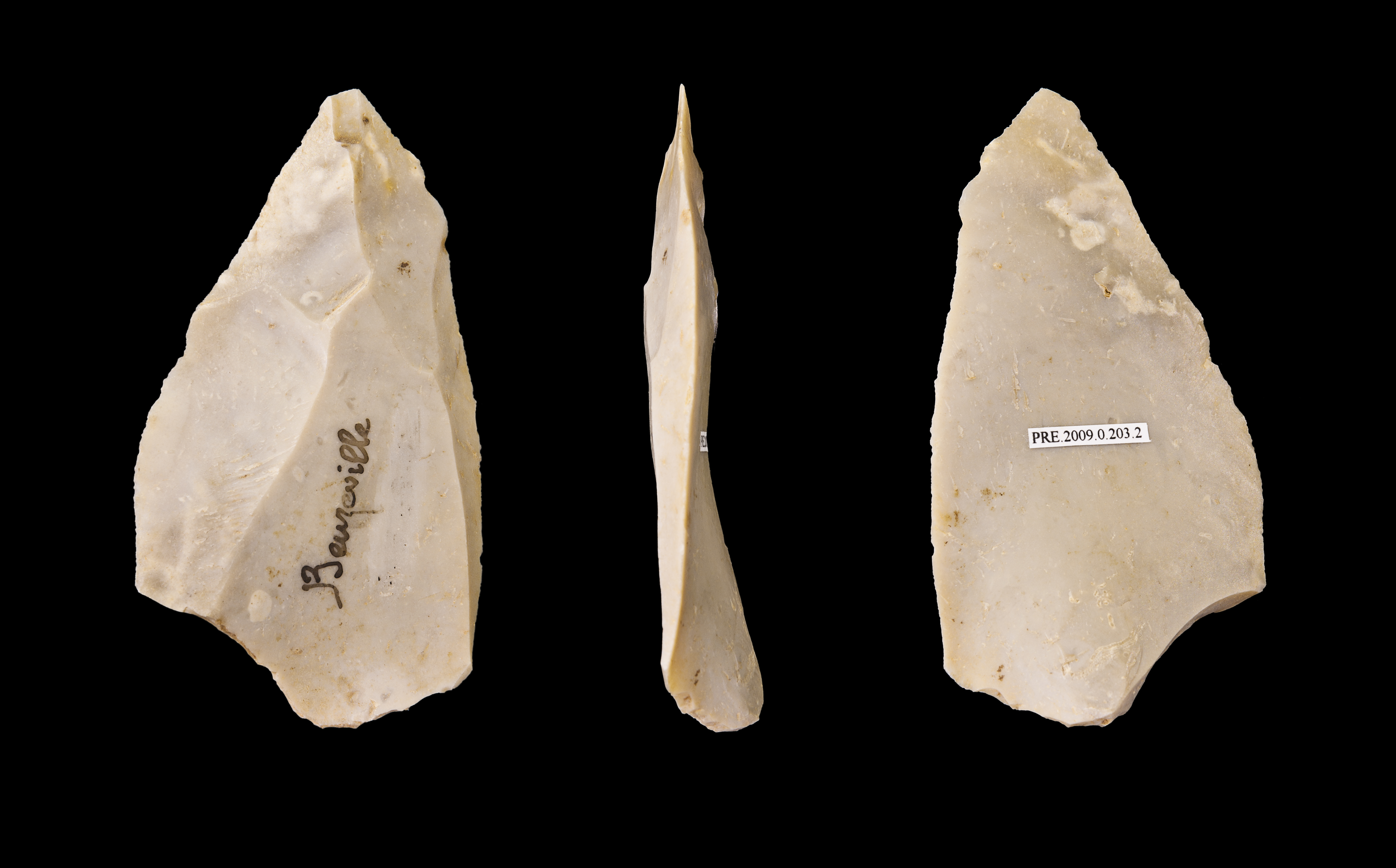 |
| Levallois points. |
 |
| Homo Sapiens. |
| Bone harpoons made by Homo Sapiens. |
EXTRAS.
Monkeys using tools:
Bonobo laughing:
3. Hunter-gatherer communities.
Paleolitic (Old Stone) age started 2.3 million years ago with the apparition of the first human beigns and ended in 10.000 B.C.Lives of early humans.
Early humans lived from hunting animals, gathering food and fishing. They didn't produce food, because of that they were predators.They hunted in groups and obtained from the animals:
- meat to eat.
- skins (hides) to make clothes.
- bones to make tools.
- tendons to make rope.
The control of fire.
- Homo Erectus discovered fire 400.000 years ago, probably by accident.
- Homo Neanderthal was the first to learn how light fires.
- keep warm.
- light their caves.
- frighten away wild animals.
- cook food.
The production of tools.
- The first tools were stones carved to make an edge for cutting. They used flint, a hard mineral that breaks into sharp pieces. They used stone tools to cut wood and meat, dig and vegetables and to shape bones.
- Later, they started to use new materials (bone an antler) that allowed them to make specialised tools such as hooks, harpoons, needles and bows.
- They made clothes from animal skins (hides). The different parts were sewn together with bone needles and thread made of animal sinew or leather.
 |
| Harpoons made of bone. |
Habitat.
People lived in caves and natural shelters and also in tents made with branches and hides.Camps were located near a source of water.
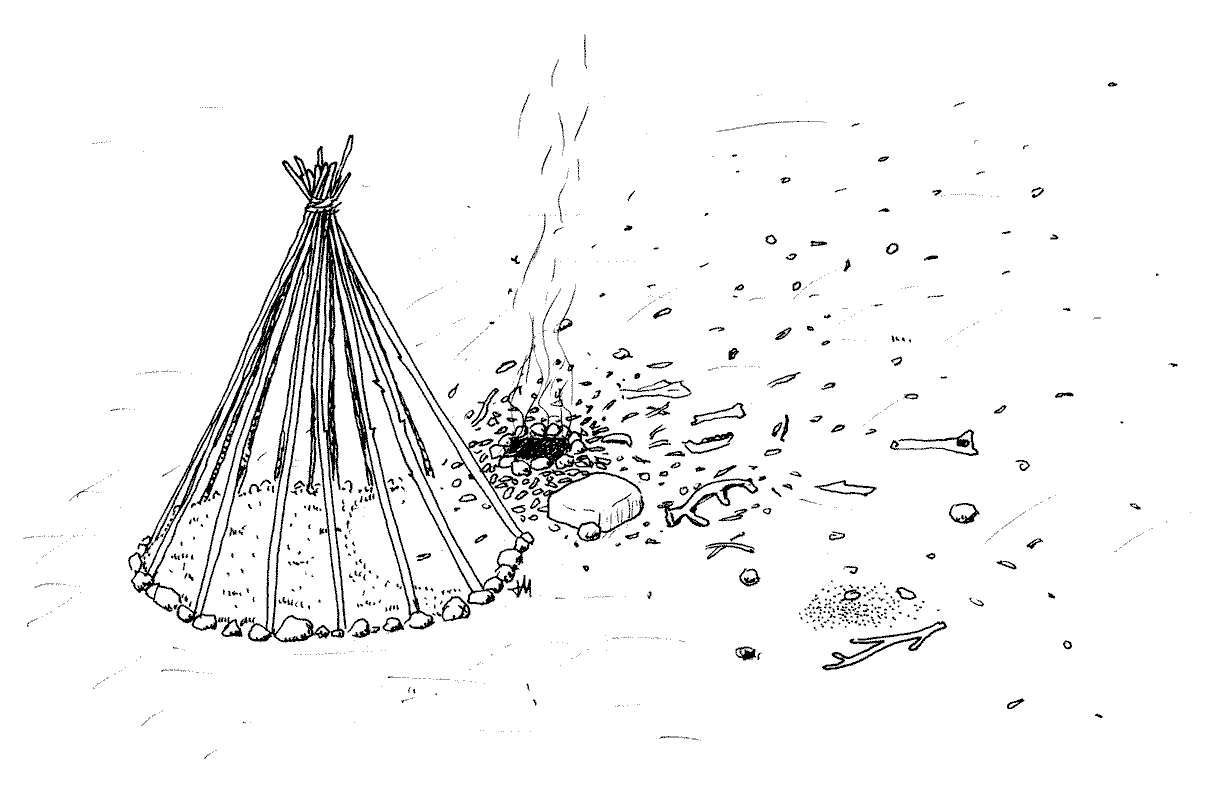 |
| Paleolithic tent. |
4. The Neolithic: the farming settlements.
The Neolithic (means New Stone) started 10.000 years ago (8.000 B.C.) with the discovery of farming.Location and expansion:
- The Neolithic appeared in the Middle East in an area called the Fertile Crescent that includes the valleys of the rivers Tigris, Euphrates and Nile.
- From the 7th millenium B. C., agriculture started to spread into Europe trhough the Mediterranean Sea and the European rivers.
- Simultaneosly agriculture was discovered in other areas of Asia and the Americas.
 |
| The Fertile Crescent. |
3. 1. Food production and sedentary life.
People in the Neolithic Age learnt from nature that new plants grew from buried seeds, developing agriculture. The first crops were:- cereals: wheat (in spanish, trigo), barley (in spanish, cebada) and rye (in spanish, centeno)
- pulses: lentils (in spanish, lentejas) and peas (in spanish, guisantes).
In order to look after their crops and animals, people settled in villages and became sedentary.
3. 2. New tasks and new tools.
- People developed the technique of polished stone. The stone was rubbed agains a hard surface to make it smooth.
- New specialised tools weere developed to undertake agricultural tasks: hoe, sickle.
- Development of pottery to store, transport and cook food. Was made from mud that was dried in the sun or baked in a kiln or oven (in spanish, horno).
- Development of weaving to make clothes and blankets out of natural fibres using:
- spindle (in spanish, huso) to create thread.
- loom (in spanish, telar) to create material.
- Development of mining to obtain semi-precious stones.
| Neolithic polished stones. |
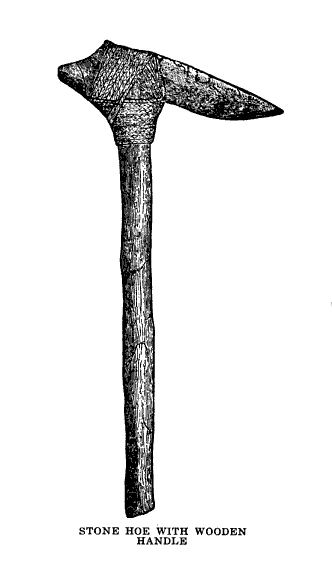 |
| Stone hoe with wooden handle. |
 |
| Neolithic pottery |
3. 3. Habitat.
- Villages were located in high ground next to rivers and protected by walls.
- Homes were built of adobe (mud and straw) and roofs wre made of branches and straw.
- Villages were self-sufficient (they consumed what they produced), but trade appeared to obtain valuable objetcs like shells and pottery.
 |
| Reconstrucion of a neolithic house. File:Archodrom Beaune 10.jpg https://fr.wikipedia.org/wiki/Utilisateur:Christophe.Finot Attribution ShareAlike 2.5 Archeodrome Beaune 10.jpg |
5. THE METAL AGES.
5. 1. The discovery of metals.
Chronology and location: Metalworking began in the Middle East around the 5.000 B. C.The first metal used was gold, that was hammered into flat sheets and used to make jewellery and ornaments.
Later, other metals: cooper (in spanish, cobre), bronze (in spanish, bronce) and iron (in spanish, hierro); were used and gave their name to the three metal ages;
- The Cooper Age (5.000 B. C.). Two techniques were developed to work with metal:
- Forging (in spanish, forjado): to heat the metal to make it easier to shape, using a hammer (in spanish, martillo) and an anvil (in spanish, yunque).
- Casting (in spanish, fundicion): to pour molten metal into a mould to make an object.
- Jewellery: necklage, bracelets, pins
- Weapons: arrows, daggers, axes.
- The Bronze Age (3.000 BC). They started to use bronze, a mixture of cooper an tin (in spanish, estaño).
- Bronze had two advantages:
- Was harder than cooper.
- Could be sharpened (in spanish, afilado) and polished (in spanish, pulido).
- Ornaments: brooches (in spanish, broche), neck rings.
- Weapons for the elite: knives, armour, swords.
- The Iron Age (2.000 BC). They started to use iron that had two important advantages:
- It is very hard and resistant.
- Allowed most of the people to have access to metal tools.
- Farming tools: scythes (in spanish, guadaña)
- Stronger weapons.
- Apparition of sailing (in spanish, navegación). They used boats powered by oars and a square sail.
- Apparition of the wheel (in spanish, rueda) made of wood and used for transport.
- Water wheels (in spanish, molino de agua) that made posible to take water from the rivers to water the fields.
 |
| Copper axe. |
 |
| Bronze Age swords. File: Apa Schwerter.jpg https://commons.wikimedia.org/wiki/User:Dbachmann. CC BY-SA 3.0 |
 |
| Casting iron. |
 |
| Forging. |
 |
| Cart of the metal age. |
5. 2. Society.
Metalworking led to several social transformations:- Apparition of specialised tasks, such as metalworking, that led to the appareance of artisans
- Growing of trade, using boats and carts (in spanish, carros) with wheels to transport goods over long distances.
- Due to the specialisation of skills, some groups started to accumulate wealth and power:
- Warriors to defend land, livestock and possessions.
- A king, who governed the community.
5. 3. Habitat
Bronze Age settlements were located on hills and surrounded by defensive walls fortified with stones and wooden stakes.Homes were either circular of rectangular with walls made adobe on a stone base and roofs made of stra supported by logs of wood.
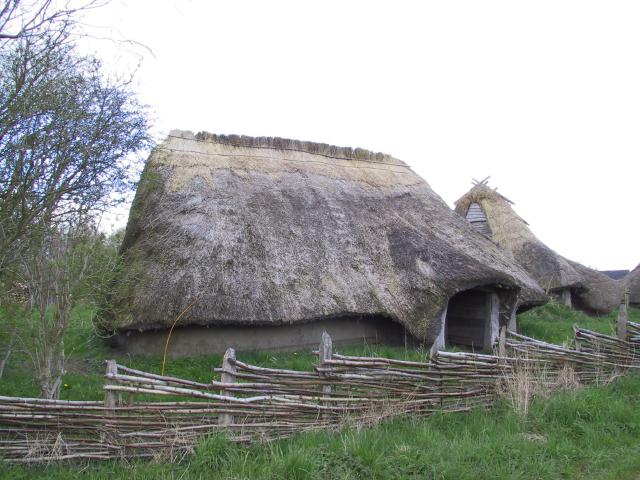 |
| Reconstruction of an Iron Age house. |
EXTRAS.
In 1991, the mummy of a bronze age man, was discovered in the Alps. The autopshy of the body has allowed us to know about how he lived, what he ate and what tools he used, but about his personal story we can only imagine.6. MEGALITHS.
Megaliths are monuments made out of very big stones (megalith comes from Greek and means "big stone"). They began to appear in Europe in the 5th millenium.Main charateristics:
- Its construction required a society with a high level of organization and the work of many people and specialised workers.
- Were built with simple stone and metal tools, logs, ropes, and using simple devices such as ramps and leavers (in spanish, palanca).
- Probably had a spiritual fuction.
- Menhir: a large standing stones used to mark territory or as a conmemorative monument.
- Dolmen: large standing stones with a stone roof. Some had a covered gallery with flat stones.
- Stone circle: upright stones and horizontal stones arranged in a circle. Its function could be related to agriculture of Sun worship.
 |
| Menhir |
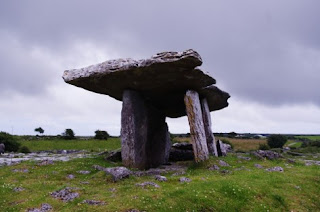 |
| Dolmen |
 |
| Stone circle. |
7. Art and magic.
About 30. 000 years ago, during the Paleolithic period, appeared the first works of art. We can distinguish two types:- cave painting (painting)
- portable art (sculpture)
7. 1. Cave painting.
Paintings that are found deep inside the caves.Their main characteristics are:- Naturalistic techniques are used (they tried to reproduce reality as precisely as possible)
- Usually depicted animals and used rock ledges to give a sense of depth.
- Sometimes also appeared scenes with human figures and geometric symbols.
- The most common colours were red, ochre and black and figures were outlined wih a black line.
- The colours were made of natural pgiments (charcoal, iron oxide, etc) mixed with animal fat to help the paint to stick to the walls, using their fingers or bird feathers.
7. 2. Portable art.
We have found small pieces of slate of calcite engraved or painted with animals. Another type of portable art were small figures known as Venus with the folowing characteristics:- Were made of stone, bone or antler.
- Show women with few facial features.
- The body parts related to fertility are exagerated.
7. 3. Meaning.
There are different theories about the meaning of the paleolithic art:- Hunting magic. They painted the animals they wanted to hunt.
- Sanctuaries. The paintings are found in the deepest parts of the caves and it is though that magic rituals were held there.
- Fertility cults. This works are related to reproduction and fertility.
 |
| Iron oxide. |
 |
| Charcoal |
 |
| Painting of a horse, Lascaux (France. |
 |
| Drawings of rhinos, Chauvet Cave (France). |
.jpg) |
| Bsions, cave of La Covaciella (Asturias). |
PREHISTORY IN SPAIN.
Paleolithic (800.000-5.000 B.C.)
The first human beigns appeared in the Iberian Peninsula 800.000 years ago during the Lower Palaeolithic Period). They have been found in the Atapuerca site (Burgos). The remains belonged to an erectus-type human species, called Homo Antecesssor. They were:- Hunter-gatherers and made stone tools.
- Practised cannibalism.
 |
| Homo Antecessor. |
During the Upper Palaeolithic Period, the Peninsula was inhabited by Neanderthals and Homo Sapiens. The Homo Sapiens left us important examples of cave painting. We can distinguish two varieties:
- Cantabrian area (Altamira) with two main characteristics:
- Eastern Spain (Cogull, Valltorta). Two characteristics:
- Located in rock shelters.
- Represented schematic human beigns involved in scenes of hunting war, and rituals.
Neolithic (5.000 b. c.-2.500 b.c.)
- The Neolithic reached the Iberian Peninsula through two routes:
- the Mediterranean
- the North of Africa.
- The most important cultures appeared in Catalonia and Andalucia, and the main art form was Cardium pottery.
Copper, Bronze and Iron ages.
Metalworking was introduced in the Iberian Peninsula from the Eastern Mediterranean by people looking for metal. We can distinguish three stages:- Copper age (2.500-2.000 b.c.). The most important culture was "Los Millares" (Almeria) with two characteristics:
- Apparition of walled settlements.
- Megalithic architecture: dolmens and large corridor tombs, called "caves".
- Bronze Age (2.000 b.c.-1.000 b.c.). The most important cultures were:
- El Argar extended from Almeria to Granada and characterised by individuals burials in earthenware vessels.
- Balearic islands characterised by its megalithic constructions: taulas, talaiot (use as defensive watchtower) and naveta (collective tomb).

Taula.
 |
| Talaiot. |
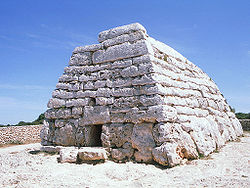 |
| Naveta. |
- Iron Age (1.000-Roman colonization). Iron was introduced by:
- the Celtic people who entered through the Pyrenees
- Phoenic and Greek colonists.
ACTIVITIES.
With an
A
|
A slow and expensive digging to recover remains buried underground.
|
Archaelogical excavation
|
With an
A
|
A cave famous because of its cave paintings located in Northern Spain.
|
Altamira.
|
With an
A
|
A period of time in which History is divided. Is shorter than an Eea.
|
Age
|
With a B
|
A metal alloy made of copper
and tin.
|
Bronze
|
With a C
|
One of the period in which is
divided the age of metals.
|
Copper Age.
|
With a C
|
A megalitic monument formed of
a number of menhirs placed in a circle.
|
Cromlech
|
With a D
|
A megalithic monument which consists in a
chamber formed of a large vertical stones roofed over with horizontal stones.
|
Dolmen
|
With an
E
|
One of the types of
periods of variable lenght in which divided History
|
Eras
|
Contains
an E
|
The first hominid to leave Africa. Also was the
first hominid to use fire.
|
Homo Erectus
|
With a F
|
Hard, sedimentary rock from the mineral
quartz used to create tools.
|
Flint
|
With a F
|
To shape a metal object by heating it
in a fire or furnace and hammering it.
|
Forge
|
With
a G
|
A technique to make stone tools that consists to
polish one stone using other to obtain a harder and sharper edge.
|
Grinding stone
|
With a G
|
One of the first animals which was domesticated.
|
Goat.
|
With a H
|
A science that studies
humanity’s past.
|
History
|
With a H
|
The long evolutive process
through which the hominids adquire their own unique features.
|
Hominisation
|
Contains a H
|
The first hominid that was
able to make tools
|
Homo Habilis
|
With an M
|
A painting in which only one colour has been used.
|
Monochrome
|
With an M
|
A megalithic monument made of a large stone placed
vertically in the ground.
|
Menhir
|
With an N
|
The period of time was goes
from 10.000 B. C. to 4. 500 B. C.
|
Neolithic
|
Contains a N
|
The first hominid who
bury their deads.
|
Homo Neanderthalensis
|
With a N
|
a painting in which forms, color and
space appear as they are in Nature.
|
|
With an O
|
One of the main characteristics that make hominids
different from the rest of the large simians. Allow them to easy manipulate
objects.
|
Opossable thumb.
|
With a P
|
The period of time that started 4. 4. Million years
ago and ended 10.000 years B. C.
|
Paleolithic.
|
With a P
|
A way of life characterised
by taking resources from Nature: other animals (hunting)
or plants (gathering); without replacing them.
|
Predatory
|
Contains R
|
One of the first plants domesticated during the
Neolithic period
|
Rice
|
Contains a R
|
way of life characterised by producing
resources: agriculture and cattleraising.
|
Productive
|
With an
S
|
A tool use to cut grain, grass, etc,
consisting of a curved hooklike blade mounted in a short handle.
|
Sickle.
|
With an
S
|
A technique to make Stone tools which
consist in strike a Stone with another.
|
Stonecarving Stone
|
With an
S
|
A megalithic monument made of a group
of menhirs set out in a row
|
Stone row.
|
With a T
|
One of the
rivers flowing through the land
between two rivers.
|
Tigris
|
Contains V
|
A small statue of women
which accentuated feminine attributes.
|
Venus
|
Contains a V
|
Paintings located on the
walls of the caves that appeared during the Paleolithic period.
|
Cave Painting
|
With a W
|
A new trade appeared during the Neolithic period
which consists into make woven textiles.
|
Weaver
|
PREHISTORY.
With an
A
|
A slow and expensive digging to recover remains buried underground.
|
Archaelogical
excavation
|
With an
A
|
A cave famous because of its cave paintings located in Northern Spain.
|
Altamira.
|
With an
A
|
A period of time in which History is divided. Is shorter than an Eea.
|
Age
|
With a B
|
A metal alloy made of copper
and tin.
|
Bronze
|
With a C
|
One of the period in which is
divided the age of metals.
|
Copper
Age.
|
With a C
|
A megalitic monument formed of
a number of menhirs placed in a circle.
|
Cromlech
|
With a D
|
A megalithic monument which consists in a
chamber formed of a large vertical stones roofed over with horizontal stones.
|
Dolmen
|
With an
E
|
One of the types of
periods of variable lenght in which divided History
|
Eras
|
Contains
an E
|
The first hominid to leave Africa. Also was the
first hominid to use fire.
|
Homo
Erectus
|
With a F
|
Hard, sedimentary rock from the mineral
quartz used to create tools.
|
Flint
|
With a F
|
To shape a metal object by heating it
in a fire or furnace and hammering it.
|
Forge
|
With a G
|
A technique to make stone tools that consists to
polish one stone using other to obtain a harder and sharper edge.
|
Grinding
stone
|
With a G
|
One of the first animals which was domesticated.
|
Goat.
|
With a H
|
A science that studies
humanity’s past.
|
History
|
With a H
|
The long evolutive process
through which the hominids adquire their own unique features.
|
Hominisation
|
Contains a H
|
The firs hominid that was
able to make tools
|
Homo
Habilis
|
With an M
|
A painting in which only one colour has been used.
|
Monochrome
|
With an M
|
A megalithic monument made of a large stone placed
vertically in the ground.
|
Menhir
|
With an N
|
The period of time was
goes from 10.000 B. C. to 4. 500 B. C.
|
Neolithic
|
Contains a N
|
The first hominid who
bury their deads.
|
Homo Neanderthalensis
|
With a N
|
a painting in which forms, color and
space appear as they are in Nature.
|
|
With an O
|
One of the main characteristics that make hominids
different from the rest of the large simians. Allow them to easy manipulate
objects.
|
Opossable thumb.
|
With a P
|
The period of time that started 4. 4. Million years
ago and ended 10.000 years B. C.
|
Paleolithic.
|
With a P
|
A way of life characterised
by taking resources from Nature: other animals (hunting)
or plants (gathering); without replacing them.
|
Predatory
|
Contains R
|
One of the first plants domesticated during the
Neolithic period
|
Rice
|
Contains a R
|
way of life characterised by producing
resources: agriculture and cattleraising.
|
Productive
|
With an
S
|
A tool use to cut grain, grass, etc,
consisting of a curved hooklike blade mounted in a short handle.
|
Sickle.
|
With an
S
|
A technique to make Stone tools which
consist in strike a Stone with another.
|
Stonecarving
Stone
|
With an
S
|
A megalithic monument made of a group
of menhirs set out in a row
|
Stone
row.
|
With a T
|
One of the
rivers flowing through the land
between two rivers.
|
Tigris
|
Contains V
|
A small statue of women
which accentuated feminine attributes.
|
Venus
|
Contains a V
|
Paintings located on the
walls of the caves that appeared during the Paleolithic period.
|
Cave Painting
|
With a W
|
A new trade appeared during the Neolithic period
which consists into make woven textiles.
|
Weaver
|







.png)
teacher this is the hole unit?
ResponderEliminarNo, Gema is only the first part of the unit (the contents about human evolution and the paleolithic), I didn't have enough time to put all the contents of the unit in the blog yet. Futhermore, I want to change some things about the first part, I think that there is too much content. By the way, remember that the correct word is WHOLE not hole.
Eliminaroh its right thanks
EliminarGema, I have just added the last content of the unit, now it is complete.
Eliminarteacher for monday s exam we only have to study till megaliths right????
ResponderEliminarEste comentario ha sido eliminado por el autor.
EliminarYes, as I have said in class, the Paleolithic Art (the content Art and Magic of your book) is not going to be a part of this exam. If you have any other doubt, please tell me.
Eliminarok thank you
Eliminar